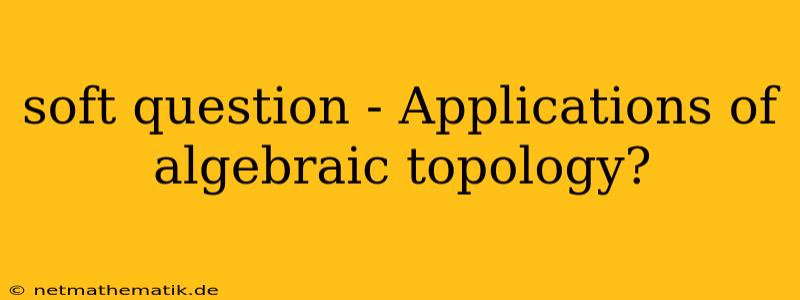Applications of Algebraic Topology: Beyond the Abstract
Algebraic topology might sound like a niche field reserved for mathematicians, but its applications extend far beyond the abstract realm of proofs and theorems. This powerful branch of mathematics provides a unique lens through which to understand and analyze complex structures in diverse fields. While its core concepts deal with the topological properties of spaces using algebraic tools, its implications reach into areas like physics, computer science, data analysis, and even robotics. Let's explore how this seemingly abstract field finds tangible applications in the real world.
Bridging the Gap Between Geometry and Algebra
At its heart, algebraic topology seeks to translate geometric information into algebraic data. This might seem counterintuitive, but the beauty lies in the ability to study complex shapes and spaces using simpler algebraic objects like groups, rings, and homology groups. These algebraic representations capture essential topological features like holes, connectedness, and dimensions.
From Topological Invariants to Concrete Applications
One of the most significant applications of algebraic topology lies in the realm of topological invariants. These invariants, derived from algebraic structures, provide a robust way to distinguish between different shapes or spaces even when they are deformed or stretched.
-
Knot Theory: Imagine trying to classify different knots, like those you might tie in a rope. Using knot invariants derived from algebraic topology, we can determine if two seemingly different knots are, in fact, topologically equivalent. This is crucial in fields like DNA research, where understanding the intricate structures of DNA molecules is vital.
-
Robot Motion Planning: Consider the challenge of programming a robot to navigate a complex environment with obstacles. By applying techniques from homology theory, we can analyze the "connectivity" of the space the robot needs to traverse. This allows us to create efficient algorithms for finding paths and avoiding collisions, ultimately leading to smoother and more effective robot navigation.
-
Data Analysis: In the era of big data, understanding the underlying structure of datasets is crucial for extracting meaningful insights. By applying persistent homology, a tool from algebraic topology, we can identify clusters and patterns within datasets. This approach finds use in areas like image analysis, where it helps to identify objects and structures within complex images.
Beyond Geometry: Exploring Connections with Other Fields
The applications of algebraic topology extend beyond the realm of shapes and spaces, connecting to diverse fields like:
1. Physics and String Theory:
-
Quantum Field Theory: Concepts from algebraic topology are used to understand the behavior of quantum fields. The intricate relationships between spaces and their algebraic counterparts provide insights into the fundamental nature of particles and their interactions.
-
String Theory: This theoretical framework in physics utilizes concepts from homology theory to describe the properties of strings, which are assumed to be the fundamental building blocks of the universe.
2. Computer Science:
-
Computational Topology: This emerging field applies algebraic topology to analyze and manipulate digital data structures. It finds use in developing algorithms for tasks like image recognition, data visualization, and even the design of algorithms for efficient data storage.
-
Network Analysis: By representing networks as topological spaces, we can use algebraic topology to analyze their properties, such as robustness and connectivity. This allows us to optimize network performance and enhance resilience against failures.
3. Economics and Social Sciences:
-
Game Theory: The study of strategic interactions between players utilizes concepts from homology theory to understand the dynamics of complex games and predict player behavior.
-
Social Network Analysis: By treating social networks as topological spaces, we can leverage algebraic tools to identify influential individuals, understand the spread of information, and analyze community structures.
Challenges and Future Directions
While the applications of algebraic topology are vast and continue to expand, there are challenges associated with its use:
-
Computational Complexity: Many algebraic topological computations can be computationally intensive, especially when dealing with complex spaces or large datasets. Developing more efficient algorithms and leveraging advancements in computational power is crucial for wider applicability.
-
Bridging the Gap: Building strong bridges between theoretical concepts in algebraic topology and their real-world applications requires collaborative efforts between mathematicians, computer scientists, and practitioners in diverse fields.
Despite these challenges, the future of algebraic topology is bright. As technology advances and our ability to handle complex data grows, the unique insights offered by this field will become increasingly valuable. With its power to unravel the hidden structures and relationships within complex systems, algebraic topology promises to play a pivotal role in addressing challenges and driving advancements in various fields.
